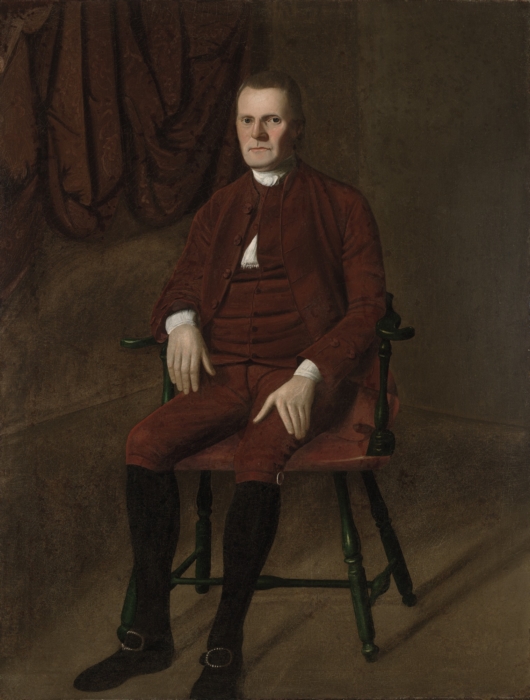
Roger Sherman
Roger Sherman (April 19, 1721 – July 23, 1793) was an early American statesman, lawyer, and a Founding Father of the United States. He is the only person to sign all four great state papers of the United States: the Continental Association, the Declaration of Independence, the Articles of Confederation, and the Constitution.[1][2] He also signed the 1774 Petition to the King.
For other people named Roger Sherman, see Roger Sherman (disambiguation).
Roger Sherman
Position established
Position established
Samuel Bishop
April 19, 1721
Newton, Province of Massachusetts
July 23, 1793 (aged 72)
New Haven, Connecticut, U.S.
Grove Street Cemetery
New Haven
Elizabeth Hartwell
Rebecca Minot Prescott
15
Born in Newton, Massachusetts, Sherman established a legal career in Litchfield County, Connecticut, despite a lack of formal education. After a period in the Connecticut House of Representatives, he served as a justice of the Superior Court of Connecticut from 1766 to 1789. He represented Connecticut at the Continental Congress, and he was a member of the Committee of Five that drafted the Declaration of Independence.
Sherman served as a delegate to the 1787 Philadelphia Convention, which produced the United States Constitution. After Benjamin Franklin, he was the second oldest delegate present at the convention. Sherman favored granting the federal government power to raise revenue and regulate commerce, but initially opposed efforts to supplant the Articles of Confederation with a new constitution.[3] After supporting the establishment of a new constitution, Sherman became a key delegate and main opponent of James Madison's Virginia Plan by introducing the Connecticut Compromise that won the approval of both the more and less populous states.[4][5][6]
After the ratification of the Constitution, Sherman represented Connecticut in the United States House of Representatives from 1789 to 1791. He served in the United States Senate from 1791 to his death in 1793.
Political career[edit]
Early political career[edit]
Despite the fact that Sherman had no formal legal training, he was urged to read for the bar exam by a local lawyer and was admitted to the bar of Litchfield, Connecticut in 1754, during which he wrote "A Caveat Against Injustice"[7][13] and was chosen to represent New Milford in the Connecticut House of Representatives from 1755 to 1758 and from 1760 to 1761. Sherman was appointed justice of the peace in 1762 and judge of the court of common pleas in 1765. During 1766, Sherman was first elected to the Governor's Council of the Connecticut General Assembly, where he served until 1785. From 1784 to 1785, he also served as a judge of the Connecticut Supreme Court of Errors.[14] Sherman served as Justice of the Superior Court of Connecticut from 1766 to 1789.
Sherman was also appointed treasurer of Yale College, and awarded an honorary Master of Arts degree. He was a professor of religion for many years, and engaged in lengthy correspondences with some of the theologians of the time. During February 1776, Sherman, George Wythe, and John Adams were members of a committee responsible for establishing guidelines for U.S. Embassy officials in Canada with the committee instructions that included, "You are to declare that we hold sacred the rights of conscience, and may promise to the whole people, solemnly in our name, the free and undisturbed exercise of their religion. And ... that all civil rights and the rights to hold office were to be extended to persons of any Christian denomination." In 1784, Sherman was elected mayor of New Haven, which office he held until his death.[7]
Death and burial site[edit]
Sherman died in his sleep on July 23, 1793, after a two-month illness diagnosed as typhoid fever.[33] The Gazette of the United States (Philadelphia), August 17, 1793, p. 508, reported an alternate diagnosis, "He was taken ill about the middle of May last, and from that time declined till his death. His physician supposed his disorder to be seated in his liver." He was buried in New Haven Green. In 1821, when that cemetery was relocated, his remains were moved to the Grove Street Cemetery.[34]
Jonathan Edwards Jr. gave a funeral sermon at the ceremony for Sherman on July 25, 1793. He praised his contributions to his friends, family, town, and country, noting Sherman's piety and excellence in study.